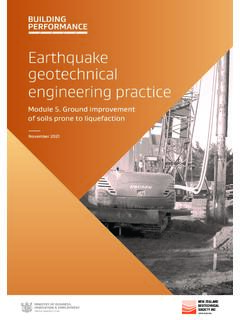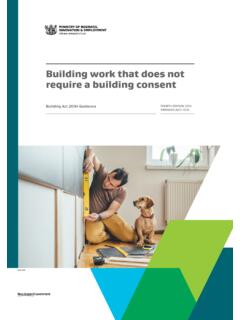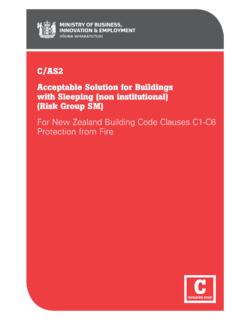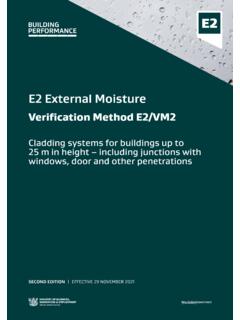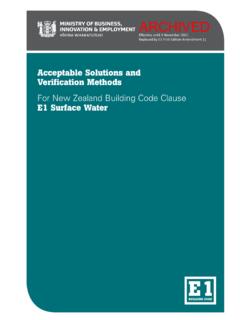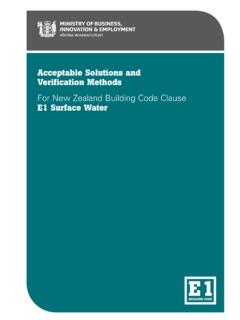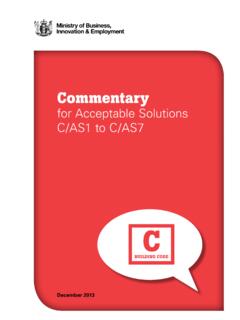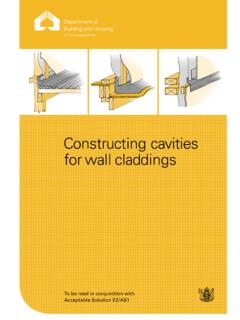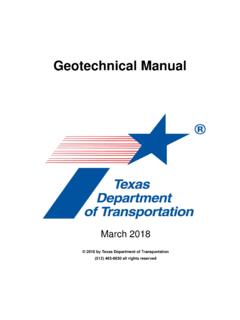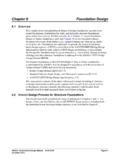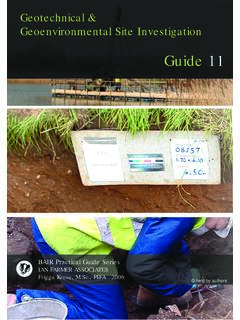Transcription of Earthquake geotechnical engineering practice
1 Earthquake geotechnical engineering practice Module 2. geotechnical investigations for Earthquake engineering November 2021. ISBN (print) 978-0-947524-45-6. ISBN (online) 978-0-947524-46-3. MODULE 2: geotechnical INVESTIGATIONS FOR Earthquake engineering . Contents iv Preface .. vi 1 Introduction .. 1. Purpose and 1. Definition of geotechnical Professional .. 2. Role of geotechnical Professional in Site Investigation .. 3. 2 Project Planning/Initiation .. 4. Project Type .. 4. 4. New Construction .. 4. Retrofit .. 4. Communication with the Wider Project Team .. 4. Initial Planning .. 5. Desktop Study .. 6. Site 6. Site Investigation Planning ..7. Specification and Procurement of Site Investigation Services ..7. Types of Investigation .. 8. Spacing of Investigation Points .. 9. Depth of Investigation .. 12. Standards and Guidelines .. 15. Data Collection and Record Keeping.
2 15. New Zealand geotechnical Database ..16. Health and Safety .. 17. 3 Site Investigation Methods ..18. Cone Penetration Testing (CPT) ..19. CPT Resolution/Accuracy .. 22. i Earthquake geotechnical engineering practice . Pore Pressure 22. Equipment Calibration/Maintenance .. 23. Baseline Readings .. 24. Piezocone Filter Elements .. 24. CPT 24. Borehole Drilling and Sampling .. 26. When to consider Machine-Drilled 26. Types of Drilling .. 26. Common Drilling Errors ..31. Soil Sampling ..31. Standard Penetration Testing (SPT) .. 38. Test Plate Load Testing .. 41. Pressuremeter Testing .. 41. Dilatometer Test .. 42. In situ Seismic Testing .. 43. Overview of Seismic Waves .. 44. Overview of In situ Seismic Test 46. Non-Invasive (Surface Wave) Methods ..48. Invasive Methods .. 58. Minimum Reporting Requirements for In situ Seismic Testing .. 64.
3 Other Geophysical Tests .. 64. Groundwater Measurement .. 65. 65. Existing Well Information .. 65. Open Boreholes .. 65. Cone Penetration Test ..66. Observation Wells and Piezometers .. 67. Water Level 67. 4 Laboratory Testing of Soil Samples ..69. General .. 69. Selection and Assignment of Tests .. 70. ii MODULE 2: geotechnical INVESTIGATIONS FOR Earthquake engineering . Visual Identification of Soils .. 71. Disturbed 71. High Quality or Undisturbed' Samples .. 71. Index Properties ..72. Moisture Content ..72. Particle-Size Distribution ..72. Atterberg Limits .. 73. Shear Strength and Cyclic Testing ..74. Consolidated Undrained Triaxial Strength (CU Test) ..74. Direct Shear (Shear Box) Test ..74. Cyclic Triaxial Test (CTX) .. 75. One-Dimensional Consolidation Test .. 76. Quality Sample Storage ..77. Sample Handling ..77. Specimen Equipment Calibration.
4 78. Testing Standards .. 78. Common Testing 78. 5 geotechnical Data Presentation ..80. Site Investigation Logs ..80. Test Investigation Locations ..81. Subsurface Profiles and geotechnical Models ..81. geotechnical Model Development Process ..81. Limitations .. 82. 6 References .. 83. Appendix A. CPT Accuracy and Resolution .. 87. Appendix B. Examples of Common CPT Output Errors and Anomalies ..89. Appendix C. CPT Fieldwork Checklists .. 97. Appendix D. SPT Drilling and Sampling Procedures for Liquefaction Assessment ..98. iii Earthquake geotechnical engineering practice . Acknowledgements NZGS/ engineering NEW ZEALAND PANEL FOR REVISION 1. Rick Wentz, ,Wentz Pacific Ltd (lead author) John Scott, , Earthquake Commission (EQC). Nick Traylen, ,Geotech Consulting Ltd (lead author) Kiran Saligame, ,Ministry of Business, Tony Fairclough, ,Tonkin & Taylor Innovation & Employment (MBIE).
5 Prof Misko Cubrinovski, ,University of Canterbury Ananth Balachandra, ,NZGS. Dr Kevin McManus, ,McManus Geotech Ltd Dr Alexei Murashev, ,WSP. Mike Stannard, , engineering New Zealand Campbell Keepa, ,WSP. (project lead) Mike Jacka, ,Tonkin & Taylor (contributor). REVIEW. Dr Liam Wotherspoon, ,University of Auckland NZGS/MBIE EDITORIAL PANEL AND CONTRIBUTORS FOR REVISION 0 (PUBLISHED NOVEMBER 2016). Rick Wentz Paul Burton, ,Geotechnics Ltd Nick Traylen Guy Cassidy, ,Engeo Ltd Tony Fairclough Dr Greg De Pascale, ,University of Chile Misko Cubrinovski Riley Gerbrandt, ,County of Santa Cruz Kevin McManus Sally Hargraves, ,Terra Firma engineering Ltd Charlie Price, ,MWH Global, NZGS Chair Iain Haycock, ,McMillan Drilling Ltd John Scott, ,MBIE Marco Holtrigter, ,Ground Investigation Ltd Gilles Seve, ,MBIE Edwyn Ladley, ,Tonkin & Taylor Mike Stannard, ,MBIE Ian McPherson, ,Aurecon Ltd Clive Anderson, ,Golder Associates Ltd Liam Wotherspoon Daniel Ashfield, ,Tonkin & Taylor MINISTRY OF BUSINESS, engineering NEW ZEALAND.
6 INNOVATION & EMPLOYMENT. Kaya Yamabe Jenni Tipler Eleanor Laban Tania Williams NZGS MANAGEMENT. Ross Roberts EQC. Jo Horrocks iv MODULE 2: geotechnical INVESTIGATIONS FOR Earthquake engineering . Document status ISBN: (print) 978-0-947524-45-6. ISBN: (online) 978-0-947524-46-3. New Zealand geotechnical Society (NZGS) and Ministry of Business Innovation & Employment (MBIE). Earthquake geotechnical engineering practice in New Zealand Rev 1. Issue date November 2021. New Zealand geotechnical Society (NZGS). c/ engineering New Zealand PO Box 12 241. Wellington 6013. Ministry of Business Innovation & Employment (MBIE). Building System Performance Branch PO Box 1473. Wellington 6140. DISCLAIMER. This document published by the Chief Executive of MBIE as guidance under section 175 of the Building Act 2004. to assist parties to comply with their obligations under the Building Act 2004.
7 It is not mandatory to follow the guidance, but if followed: it does not relieve any person of the obligation to consider any matter to which that information relates according to the circumstances of the particular case;. users should consider taking appropriate professional advice prior to entering into a construction contract which incorporates all or parts of this document. While MBIE, engineering New Zealand, and the NZGS have taken care in preparing this document, it is only a guide. It is not a substitute for legal advice or legislation. All users should satisfy themselves as to the applicability of the content and should not act on the basis of any matter contained in this document without considering, and if necessary, taking appropriate professional advice. The document may be updated from time to time and the latest version is available from the Ministry's website at or the New Zealand geotechnical Society's website at IMPORTANT NOTICE.
8 The contents may be subject to changes, additions, and deletions. Submissions by the geotechnical community to the Society are encouraged, as it is intended that the guidelines will be updated from time to time. COPYRIGHT. The copyright owner authorises reproduction of this work, in whole or in part, so long as no charge is made for the supply of copies, and the integrity and attribution of the contributors and publishers of the document is not interfered with in any way. v Earthquake geotechnical engineering practice . Preface This document is part of a series of guidance modules developed jointly by the Ministry of Business, Innovation & Employment (MBIE) and the New Zealand geotechnical Society (NZGS). The guidance series along with an education programme aims to lift the level and improve consistency of Earthquake geotechnical engineering practice in New Zealand, to address lessons from the Canterbury and Kaik ura earthquakes and the Canterbury Earthquakes Royal Commission recommendations.
9 It is aimed at experienced geotechnical professionals, bringing up to date international research and practice . This document should be read in conjunction with the other modules published to date in the series: Module 1: Overview of the Guidelines Module 3: Identification, assessment and mitigation of liquefaction hazards Module 4: Earthquake resistant foundation design Module 5: Ground improvement of soils prone to liquefaction Module 5A: Specification of ground improvement for residential properties in the Canterbury region Module 6: Earthquake Resistant Retaining Wall Design On-line training material in support of the series is available on the MBIE and NZGS websites, and Undertaking adequate geotechnical investigations to understand likely ground performance in earthquakes is an essential aspect of good and economic building design. We would encourage you to make yourselves familiar with the guidance and apply it appropriately in practice .
10 Eleni Gkeli Jenni Tipler Chair Manager Building Performance and engineering New Zealand geotechnical Society Ministry of Business, Innovation & Employment vi MODULE 2: geotechnical INVESTIGATIONS FOR Earthquake engineering . 1 Introduction Purpose and Scope This guidance document (Module 2). is part of a series of Earthquake geotechnical engineering practice guidelines and should be read in conjunction with the rest of the series. It is intended that this document will be primarily used by geotechnical Engineers, engineering Geologists and their staff to scope, execute and review geotechnical site investigations. This document has three primary objectives: 1 The promotion of good practices for the collection of consistent, high quality and reliable factual geotechnical data for the purposes of Earthquake geotechnical engineering (primarily for buildings).
